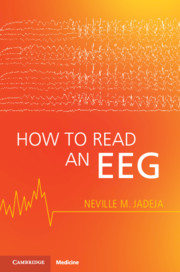Book contents
- How to Read an EEG
- How to Read an EEG
- Copyright page
- Dedication
- Contents
- Figure Contributions
- Foreword
- Preface
- How to Read This Book
- Part I Basics
- Part II Interpretation
- Chapter 9 Approach to EEG Reading
- Chapter 10 Background
- Chapter 11 Foreground (How to Describe an Abnormality)
- Chapter 12 Common Artifacts
- Chapter 13 Normal Variants
- Chapter 14 Sporadic Abnormalities
- Chapter 15 Repetitive Abnormalities
- Chapter 16 Ictal Patterns (Electrographic Seizures)
- Chapter 17 Activation Procedures
- Part III Specific Conditions
- Appendix How to Write a Report
- Index
- References
Chapter 12 - Common Artifacts
from Part II - Interpretation
Published online by Cambridge University Press: 24 June 2021
- How to Read an EEG
- How to Read an EEG
- Copyright page
- Dedication
- Contents
- Figure Contributions
- Foreword
- Preface
- How to Read This Book
- Part I Basics
- Part II Interpretation
- Chapter 9 Approach to EEG Reading
- Chapter 10 Background
- Chapter 11 Foreground (How to Describe an Abnormality)
- Chapter 12 Common Artifacts
- Chapter 13 Normal Variants
- Chapter 14 Sporadic Abnormalities
- Chapter 15 Repetitive Abnormalities
- Chapter 16 Ictal Patterns (Electrographic Seizures)
- Chapter 17 Activation Procedures
- Part III Specific Conditions
- Appendix How to Write a Report
- Index
- References
Summary
Electrode artifacts may have a spiky, periodic or rhythmic appearance. Characteristically, it is limited to the involved electrode with no field. Sweat artifact may involve multiple channels and may be confused with lateral eye movements or GRDA. Eye movement and glossopharyngeal artifact may mimic frontally predominant GRDA. EKG artifact may be confused with periodic discharges. Characteristically, it corresponds to the QRS complexes. Ventilatory artifact may be confused with bursts of cerebral activity. Characteristically, it corresponds to the respiratory rate. Head tremor presents as occipital predominant rhythmic artifact. Maneuvers and devices such as bed-percussion, CRRT, ECMO, CPR and even brushing teeth may lead to ictal appearing rhythmic artifacts.Discharges associated with cortical myoclonus are best appreciated in the central channels as these are relatively free of muscle artifact. Chewing artifact may electrographically mimic a generalized tonic clonic seizure
- Type
- Chapter
- Information
- How to Read an EEG , pp. 83 - 97Publisher: Cambridge University PressPrint publication year: 2021

